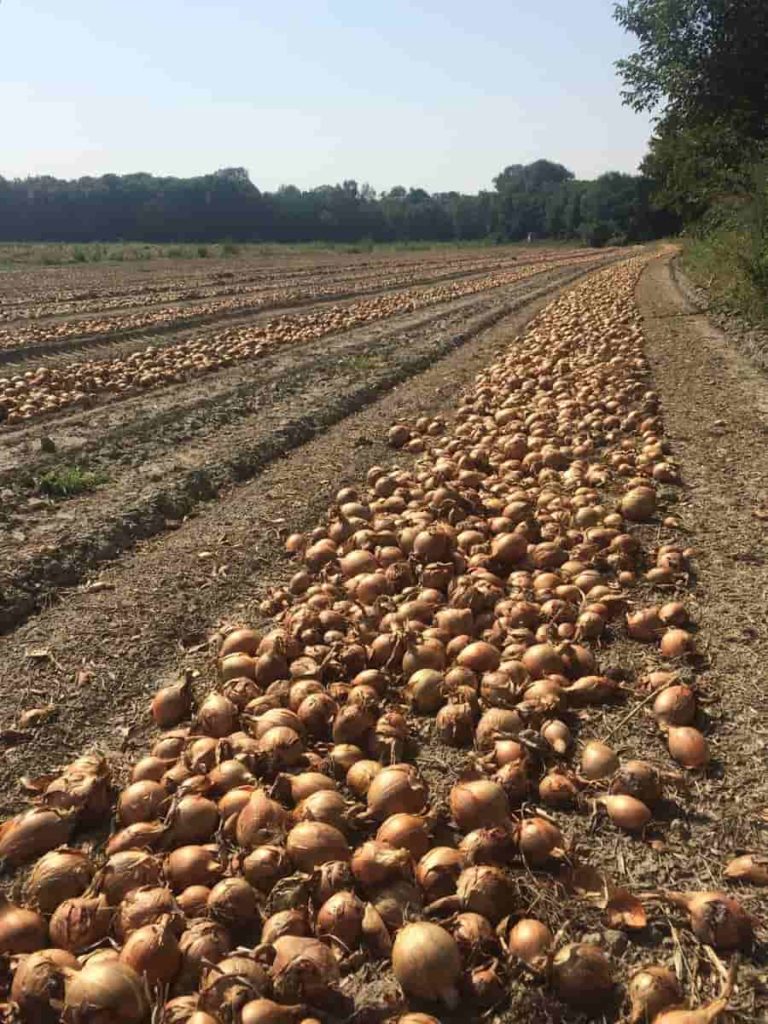The onion is a hardy cool-season yearly-two crop but is usually cultivated as an annual crop. The onion has hollow, narrow leaves and a base which enlarges to form a bulb. A bulb is composed of underground stems surrounded by fleshy modified leaves that envelop a central bud at the tip of the stem. This bulb can be white, yellow, or red and can take up to 80 to 150 days to reach harvest.
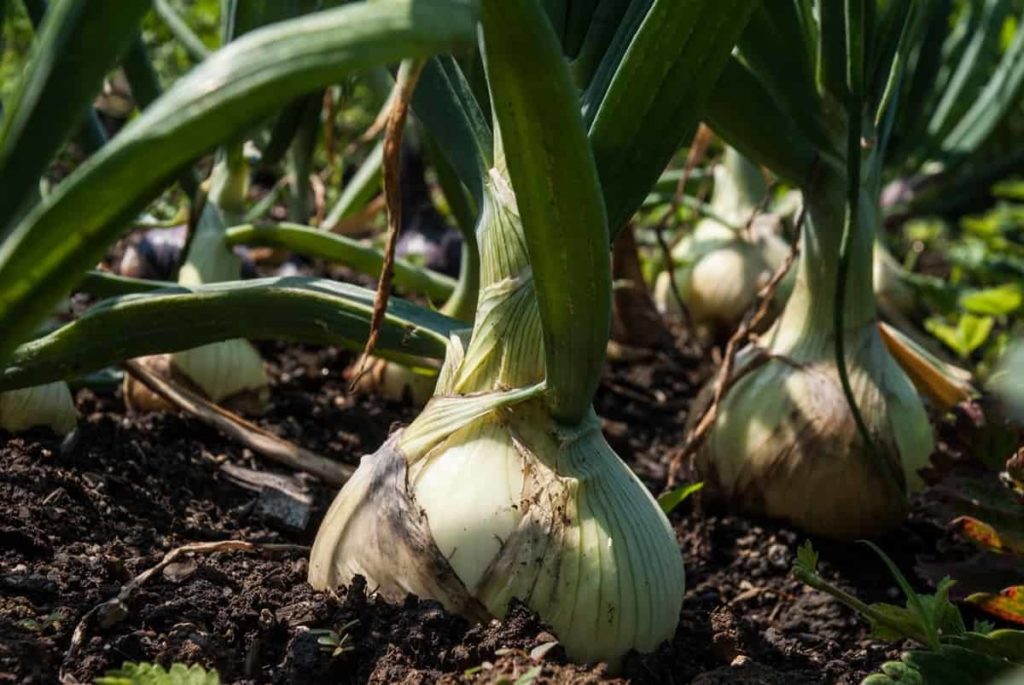
Onion is characterized by its distinctive flavor and acuteness due to sulfur-containing compounds in the bulb scales. India is in second place in growing onions in the world. Indian onions are popular for their acuteness and are available around the year. Onion is an important and one of the most consumed vegetable crops in Southern India and Tamilnadu.
Onion farming in Tamilnadu
Best areas for growing onions in Tamilnadu
Perambalur district is specifically known for Onion cultivation, which is highly preferred for its good quality. Onion is mainly cultivated in Perambalur, Tiruchi, Namakkal, Tiruppur, Erode Coimbatore, and Dindigul districts. Shallot is a popular onion variety in Tamilnadu, and the major Shallot-producing districts are Dindigul, Tiruppur, Perambalur, Trichy, and Namakkal. These shallots have for nearly 75 percent of the total onion produced in Tamil Nadu, with a productivity of 12 tonnes per hectare.
Suitable soils for growing onions in Tamilnadu
Onion can be well grown in all soil types, such as sandy loam, clay loam, silt loam, and heavy soils. However, deep, friable loam and alluvial soils are the best soil for successful onion farming. The soil should have good moisture holding capacity, sufficient organic matter, and water drainage. Red loam to black soils with good drainage facilities is also suited for onion cultivation. The required pH value for onion farming should be between 6-7, and you will get maximum yield when onions are cultivated in the mild season without extremes of heat and cold.
Soil bed preparation in onion production
After ploughing, the fields are levelled, and then beds will be prepared. Depending on the season, the beds will be flat beds or broad bed rows. This farming guide will give you an idea about bed preparation and requirement. Flatbeds are commonly 1.5-2 meters in width and 4-6 meters in length. Broad bed furrows generally have a height of 15 cm and top width of 120 cm. The furrows are 45 cm deep to get the right spacing.
In case you missed it: Tomato Farming Guide for Beginners: Production Techniques, Process, and Steps
Onion crops can be successfully grown on heavy soil with organic manure and field preparation before planting. Onions are cultivated in broad soil bed furrows during the Kharif season since it is simple for excess water to drain out. It also facilitates reduces the occurrence of Anthracnose disease. Flatbeds are made if onion cultivation is done during the rabi season. Flatbeds for Kharif can lead to water logging.
For raising in the nursery, the raised bed should be a height of 10-15 cm and a width of 1.0 – 1.2 m, and the length should be planned as per convenience. The bed distance should be at least 30 cm so that water movements are uniform and excess water drainage is possible. A raised bed is recommended for the nursery because water moves from one end to the other in the case of a flatbed, and there is a possibility of washing away seeds. Excess water drainage is also a major problem with the flatbed method of raising seedlings.
Best onion varieties to grow in Tamilnadu for high yield
Pusa Red
The color of this type of onion is red. The crop yield is at least 200 to 300 quintals per hectare. These onions do not require a special storage place; you can keep them anywhere. An onion generally weighs from 70 to 80 grams. The crop is cultivated and ready for harvest in 120-125 days. This bulb is medium in size, flattish round, and with poor acuteness. The variety requires short to intermediate day length.
Pusa Ratnar
The shape of this onion variety of onions is somewhat flattened and round. Farmers can get 400 to 500 quintals per hectare with this dark red-colored onion variety. This variety of onion corp gets ready and can be harvested within 125 days from sowing.
Hisar-2
This type of onion also has a color of dark red and brown. The crop matures and is ready for harvesting 175 days after transplanting. The special in this variety is that its taste is not very spicy and yields around 300 quintals per hectare.
Pusa White Flat
These are the white-colored onions that are generally seen in the market. This onion crop will grow and be ready for harvesting in 125 to 130 days after transplanting. Shelf life is for these onions also good. Farmers can yield around 280-300 quintals per hectare.
In case you missed it: Tomato Farming Guide for Beginners: Production Techniques, Process, and Steps

Pusa Madhvi
The bulbs in this variety are roundish flat, light red, 11-13% with good quality. This crop matures in 130-135 days after transplanting. This onion-type crop yields 300-350 quintals per hectare.
Spacing for onion plants and rows
Onions should be planted 2 to 4 inches apart, with 12 to 18 inches between rows. Once the seedlings have grown, onion seeds can be sown closely and thinned out. Small immature onions need to be spaced like onion plants. It is quick and easy to grow bulbing, or storage, onions while using sets. Be selective when planting sets; only use those no larger than three-quarters of an inch across. Planting the onions with sufficient space also makes it easier to control weeds.
Plants per hectare and acre
If you have planned for line to the line, plant distance of 25 to 30 cm, plant to plant distance must be 20 cm. Thus, per square meter area,15 onion plants are required. So, per hectare, there will be 150000 onion plants. On average, one acre of farming land requires approximately 60000-61000 plants; if you have planned to plant with a plant distance of 20 cm with a row spacing of 25 to 30 cm.
Best season to grow onions in Tamilnadu
The onion is a hardy cool-season yearly-two crop but is usually grown as an annual crop. Generally, onions have two crop cycles per year; the first harvesting starts in July to September and the second from October to November.
Sowing – planting methods of onions
Proper management and transplanting operations are important in the onion crop. It is the primary step in onion cultivation. About 500 square meters of bed area and about 5-7 kg seeds are required to get seedlings to transplant in one hectare. Before sowing, seeds should be treated with non-systemic fungicide at 2 grams per kg of seed to avoid damage from damping off disease.
Seeds should be sown in lines 50 mm to 75 mm distance to facilitate the removal of seedlings for transplanting, for quick weeding, and to spray pesticides easily. After sowing, the seeds should be protected by covering them with fine powdered farmyard manure or compost, followed by light watering. Incorporating a drip or micro sprinkler irrigation system helps in saving irrigation water.
Broadcasting in beds or direct sowing
Seeds of big onion types are sown directly in lines, 30 cm apart, to give proper spacing for the development of bulbs. Seeds of small onion types are broadcasted in small flat beds, thinned later. For broadcasting seeds directly in the field or sowing in the row, 20-25 kg seeds per hectare are used.
Generally, seeds are sown in lines 30 cm apart from September-October. After sowing, hand hoeing is done to send the seeds to a depth of approximately 3 cm. Hand watering or light irrigation should be given immediately after covering the seeds. Weeding is recommended at ten days intervals to prevent choking of seedlings by weeds.
Water requirement and irrigation schedule in onions
The irrigation requirement of onions depends upon the season, soil type, irrigation method, and crop age. In general, onion plants require irrigation at the time of transplanting, three days after transplanting, and subsequently at 7-10 days intervals depending on soil moisture. The Kharif crop generally needs 5-8 irrigations, while the Rabi crop needs 12-15. Onion, a shallow-rooted crop, needs frequent irrigation to maintain optimum soil moisture for good growth and bulb development.
In case you missed it: How to Start Dragon Fruit Farming/Pitaya in Thailand: A Step-by-Step Guide for Beginners
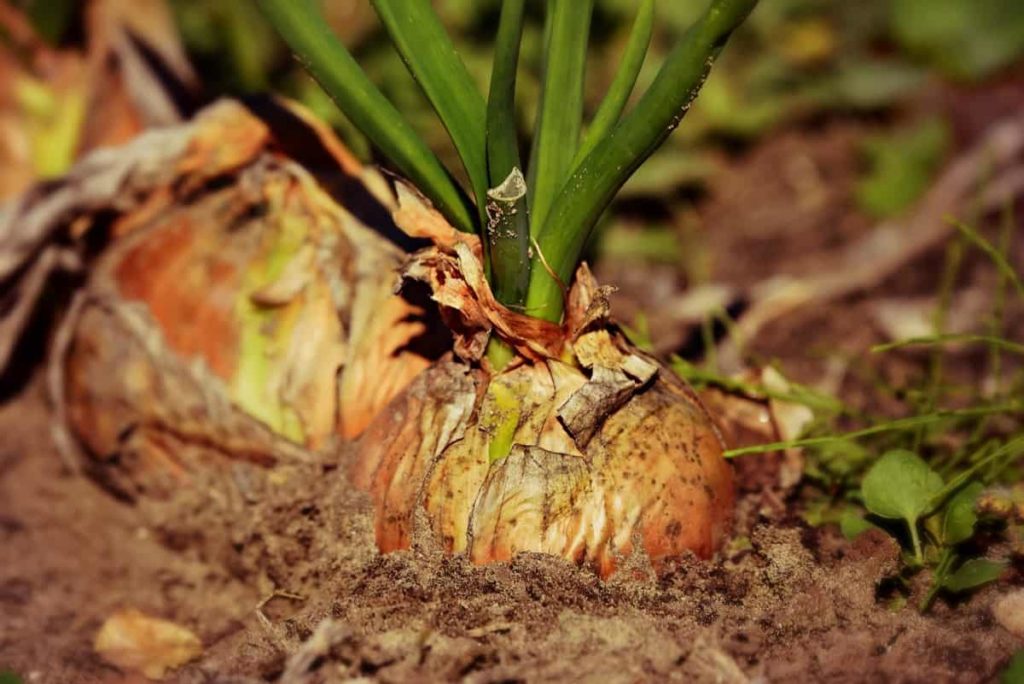
Watering must be stopped when the crop attains its maturity, and the top starts falling, reducing the risk of rotting during storage. Excess irrigation is always harmful, and a dry spell followed by irrigation will result in the splitting of the outer scales and the formation of bolters. Water loss with flood irrigation is too high due to conveyance, seepage, and percolation losses.
Water use of onions changes considerably throughout the growing period and with weather conditions. Transplanted onions need to be watered very soon after setting. About one-half inch applied will establish good contact between the soil and roots and assure a good stand.
Drip irrigation in onion farming
Onions need irrigation consistently to prevent drought and waterlog. A drip watering system must be incorporated to overcome these watering problems. It uses tubing or tape that allows water to seep into the soil without wetting foliage that will cause disease. Drip irrigation reduces water consumption and provides a more accurate way to irrigate the onion crop for a large yield, and the drip irrigation installation steps include
- Create a 3-inch deep furrow between the onion rows using a hand trowel.
- Lay drip tape into the furrow.
- Connect a drip irrigation connector kit to the water spigot. This kit will have a backflow preventer, pressure regulator, filter, and tubing adapter.
- Attach the tape to the tubing adapter in the connector kit.
- Fill the dug furrow with the 3 inches of topsoil removed at the project inception using the hand trowel.
- Turn on the water and observe the watering.
Weed control in onion farming
Controlling weed growth on the farm is one of the basic maintenance steps. Proper weed management is required to obtain high and quality yields. Some of the most commonly used methods to control the weed include chemical and cultural methods.
Chemical method
This method makes the use of herbicides. This method is the most preferred because it is fast and easy to apply, and there is no mechanical damage to the crop. And also, it is cost-effective. Weeds with similar morphological factors to the crop are effectively controlled with chemical weed control.
Cultural method
The cultural method is a traditional practice that helps in weed management, which includes
- Try to plant early maturing onion types.
- Using thoroughly cleaned seeds
- Supplying irrigation water that is free from weed seeds
- Using mulching
- Crop rotation
- Hand pulling/uprooting the weeds
Manures and fertilization in onion farming
The amount of manure and fertilizer will depend on the climate and soil type. Onion requires a high source of nitrogen. For good production, 20-25 tonnes of well-decayed cow dung per hectare should be mixed at the time of final preparation of the field. When transplanting, nitrogen, phosphorus and potash should be applied well in the soil. And also, nitrogen should be given as a top dressing at the interval of 30 days.
Onion cultivation requires 100 kg of nitrogen, 40 kg of phosphorus, and 60 kg of potash per hectare. Sulfur is also an important nutrient for better yield and is recommended to use at the time of transplanting. It requires 50 kg sulfur at the rate per hectare. In areas with zinc deficiency, zinc sulphate of 25 kg should be applied per hectare before planting or after transplanting.
Pruning in onion plants
To help get the onion starts to a strong and viable size, it is a good idea to trim them periodically while they are growing. When the plants reach 5 inches tall, use scissors to cut them back to 2 inches, as this will encourage the plants to grow thicker and stronger, and you can also use these onion trimmings in sandwiches and soups. It is not hard to do, but it will give bigger, better, stronger plants and produce well-sized onions.
Onion production using plastic mulch
Mulching is an effective cultural practice to ensure crop production, especially in the dry season. Various mulches like black plastic, transparent plastic, rice straw, sawdust, and water hyacinth were reported to conserve soil moisture efficiently in onion farming. Cultivation with the help of mulch and drip irrigation has many advantages. Adjusting soil temperature based on the needs of the product, optimizing the amount of water used, achieving cleaner food, and decreasing pesticides can be done by mulching.
In case you missed it: How to Start Sweet Potato Farming in Asia: A Guide of Cultivation for Beginners
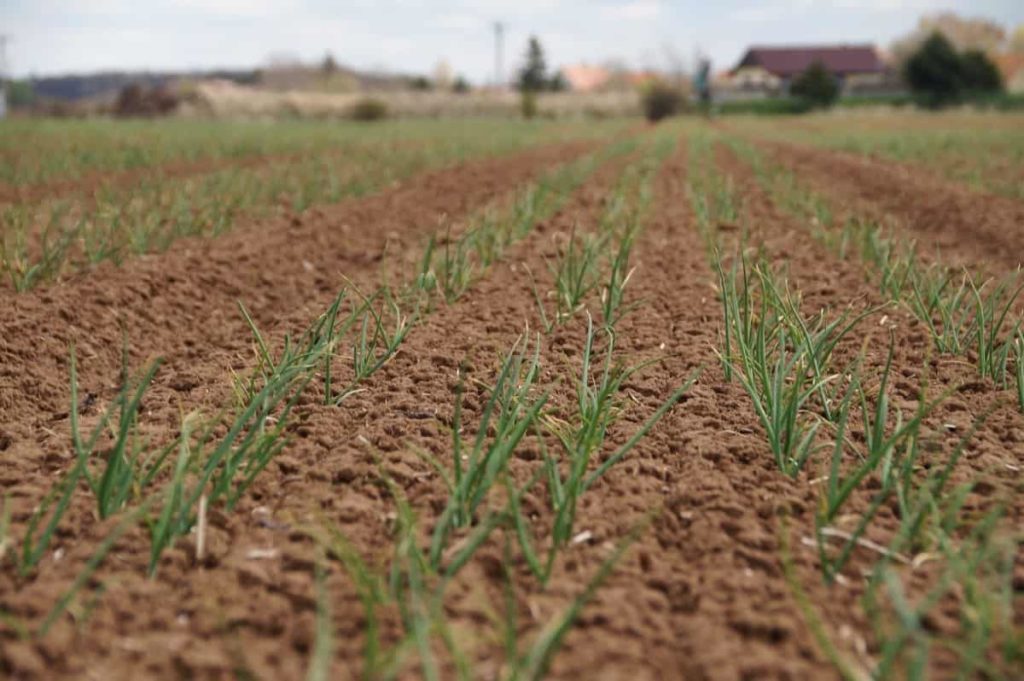
In the case of the farming of onions, the plasticulture mulch technique has offered excellent results. One advantage of black plastic films is that they absorb the sunlight, allowing the soil temperature to increase in cooler areas, thus promoting the early development of the onions in a more suitable environment. Grass clippings or leaves can also be used as mulching. Mulching the onions with hay keeps the weeds and traps them in moisture.
Onion Plant Problems – Pests and Diseases
Diseases in onion plants
A large variety of diseases and disorders affect onions crops. Fungi or bacteria cause most diseases, whereas disorders may be caused by adverse weather, air pollutants, soil conditions, nutritional imbalances, and pest control products. Sometimes several diseases or disorders can be present simultaneously. The following are the commonly seen diseases in the onion corps caused by either fungi or viruses,
- Pythium seed rot (Damping off)
- Purple blotch
- Stemphylium leaf blight
- Colletotrichum blight/anthracnose/twister disease
- Fusarium basal rot/basal rot
- White rot (Sclerotial rot)
- Pink root rot
- Black mold
- Bacterial soft rot
- Iris yellow spot disease
- Onion yellow dwarf disease
- Downy mildew
- Green mold
- Bacterial brown rot
Pests in onion plants
Fortunately, onion crops are not affected by many pest problems that commonly occur in other vegetable crops. Onions act as a natural pest repellent for the whole garden. Various pests attack onions crops, like nematodes, stem and bulb eelworm, thirps, and onion fly or maggot. Directly applying insecticides to the root zone is the most effective way of controlling maggot damage. Insecticides can be applied as a narrow band with enough water to penetrate the root zone. For direct seeded crops, apply insecticides over the row.
Cultural practices that help reduce damage from thrips include destroying volunteer onion plants and not planting onions near cereal grain fields that can serve as a source of thrips. As cereal crops mature and senesce, the adult thrips will migrate off the cereal plants and seek out neighboring green plants, including onions. Heavy rains and overhead irrigation can wash thrips off of onion leaves.
Onion Harvesting Time and Procedure
Onion crop harvesting can be done when the still green tops start drooping. The plants should be gently pulled out from the soil. Irrigation of the field is stopped 10-15 days before harvesting. The crop is also sprayed with fungicide 30 days before harvest. This fungicide spraying on plants helps to increase the shelf-life of the crop. The bulbs are cleaned and dried in the shade for four days. In addition to good planting, you must know when to harvest onions for the best flavor.
In case you missed it: How to Start Gardening at Home for Beginners: A Full Planting Guide for Flowers, Fruits, Herbs, and Vegetables
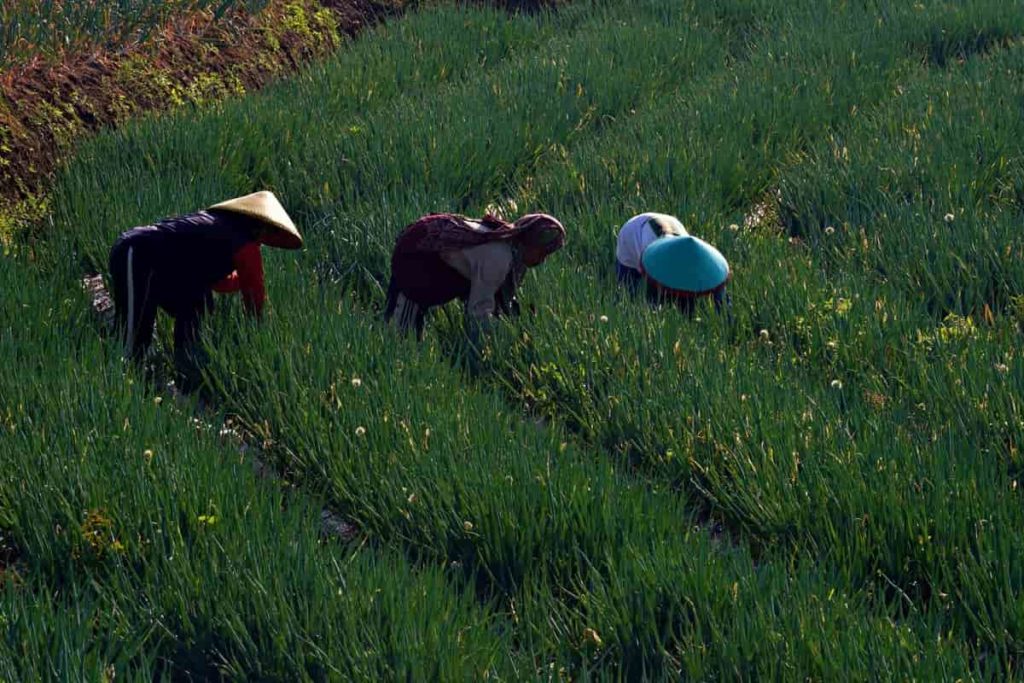
Trim greens for green onions as soon as they reach 6 inches in height and can be used as ingredients in sandwiches and soups. They become stronger if you have waited a long time to harvest the green tops. Bulbs that have bolted, or formed any flower stalks, can be pulled and used right away; they are not good for storage. Bulb onion harvest time will start when onion tops naturally fall over and brown. This harvesting is usually done 100 to 120 days after planting, depending on the variety. Onion harvest time should be in the early morning when temperatures are not too hot.
Onion harvesting
Knowing how to harvest onions is important to avoid damaging plants or bulbs. Carefully pull or dig up onions from the ground with the tops intact. Shake the soil gently around the bulbs to separate the soil from the bulbs. Harvesting the onions in late summer, before the onset of cool weather, would be best to prevent spoilage or damage from the direct sunlight. Bulb onions should be harvested approximately 100 to 125 days after planting and may vary slightly based on the onion type.
Onion yield per acre, hectare, and per plan
In one hectare of agricultural land, produced onions yield most of the time changing. This yield number can not always be fixed, but there is a yield range between 100 to 120 quintals per hectare. On average, one healthy onion plant produces 80 grams weight of onion. You can plant approximately 15 plants in one square meter and get 1200 grams of onions. The size of onions yield depends on the type of sowing seed. There are differences in yield size and weight according to the type of seed.
Onion Production in Polyhouse in Tamilnadu
A greenhouse, often known as a polyhouse, is a building or house made of polyethylene. This translucent glass-like substance allows plants to thrive and flourish in controlled environmental conditions. Although it is a temperate crop, Onion farming in a polyhouse can be possible under sub-tropical, temperate, or tropical climates. Mild and gentle weather that is not too rainy, cold, or hot is ideal for Onion farming.
Though the onion requirement for Tamilnadu is 7 lakh tonnes per year, currently, the state produces only 3 lakh tonnes. To overcome this shortage issue, The Tamilnadu government will introduce an Onion Cultivation Mission to boost onion cultivation in the state and create cultivation and storage facilities.
Through this mission, the farmers will benefit by issuing loans or subsidies to construct polyhouses and implement new farming methods to increase productivity. This mission also facilitates storage houses so the farmers can be brought their crops to the market when there is a shortage.
- How to Raise Pigs in Your Own Backyard: A Comprehensive Guide
- Budget Friendly Sheep Shed Ideas: Cheap and Low-Cost Tips
- How Much Do Cattle Farmers Make: Revenue Streams in Cattle Farming
- Management Pests and Diseases in Your Cotton Field
- Sheep Farming Business Plan for Beginners
- Aquaponic Farming at Home: A Step-By-Step Guide
- Profitable Village Farming Business Ideas in 2024
- High-Yield Aquaculture: Fast-Growing Fish for Farming
- Effective Fish Pond Construction Techniques for Beginners
- Irrigation and Water Management in Pineapple Farming
- Blossom to Harvest: Mastering Flowering and Pollination in Papaya Farming
- Pig Fattening Essentials: From Selection to Sale for Beginners
- Raising Wagyu Cattle: A Complete Guide for Premium Beef Production
- Soil Types and Their Water Holding Capacity
- Optimizing Irrigation Schedules for Coconut Groves for Enhanced Yield
- Espresso Your Garden: Coffee Grounds for Healthier Acid-Loving Plants
- The Best Soil Mix for Snake Plants: How to Mix Your Own Snake Plant Soil
- Green Thumb Success: Expert Tips for Cultivating Greenhouse Beans All Year Round
- Bloom All Year Round: The Ultimate Guide to Indoor Hyacinth Care
- Eco-Friendly Gardening: How to Make Liquid Fertilizer from Kitchen Waste
- Ultimate Guide to Grow Anise in Pots: Explore Seed Propagation to Harvesting
- Guide to Raising Chester White Pigs: Discover Breed Facts to Growth Management
- Mastering the Elegance: The Ultimate Guide to Weeping Cherry Tree Care, Planting, and Maintenance
- Ultimate Guide to Planting Garlic in Grow Bags: Growing Strategies for Beginners
- How to Fix Spider Plant Leaf-Related Problems: Natural and Organic Remedies
- 10 Reasons Why Your Tulsi Plant is Shedding Leaves: Home Remedies and Solutions
- Optimizing Growth and Yield: The Advantages of Palm Bunch Ash Fertilizer
- Utilizing Neem Oil Extract as a Natural Pesticide for Hydrangea
- From Soil to Harvest: Various Ways in Which Farmers Can Use AI Tools
- Steps to Encourage and Induce Citrus Flowers: A Comprehensive Guide
- How to Fix Snake Plant Leaf-Related Issues: Natural and Organic Remedies
- Transform Your Garden into a Fragrant Oasis with Raat Ki Rani (Night Blooming Jasmine)
- Discover the Ideal Chicken Breeds for Philippine Farms
- How to Create a Poultry Egg Farm Business Plan for Profits
- Grow Lemon Cucumbers Like a Pro: Insider Techniques for Bountiful Yields
- Ultimate Guide to Caring for Your Pink Princess Philodendron: Tips for Thriving Variegation

